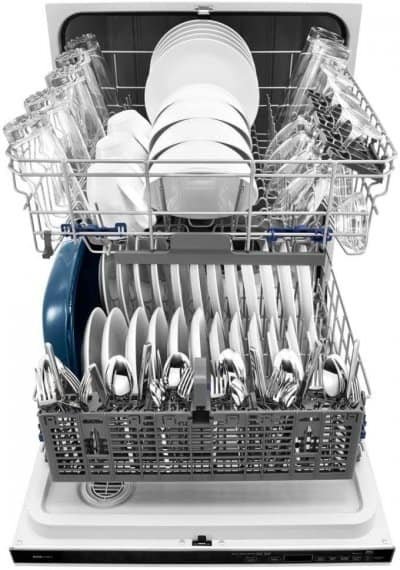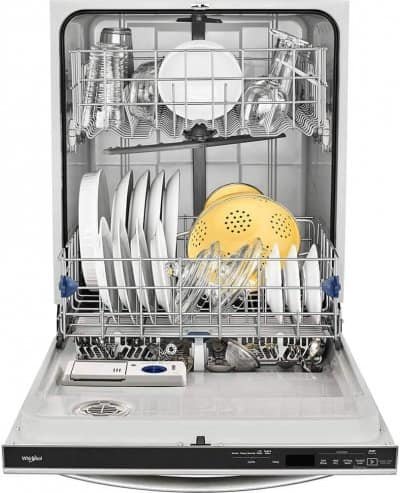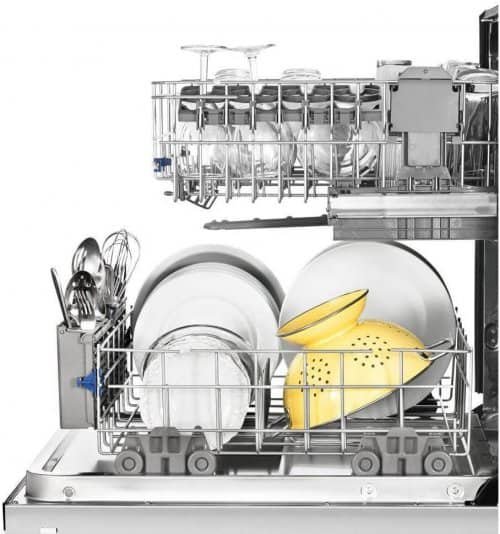Have you ever wondered why your dishes sometimes come out of the dishwasher still dirty or with spots and residue? Properly loading a dishwasher is essential for achieving efficient cleaning and spotless results. In this article, we will guide you through the step-by-step process of loading a dishwasher effectively, helping you optimize its performance and save valuable time. Say goodbye to handwashing and let your dishwasher do the work for you!
Loading a dishwasher may seem like a simple task, but there are several factors to consider in order to achieve optimal cleaning. From understanding the dishwasher’s capacity and settings to organizing different types of dishes, this article will provide you with practical tips and techniques to ensure sparkling clean results every time.
Table of Contents
Understanding the Dishwasher’s Capacity and Settings
Before diving into the loading process, it’s important to familiarize yourself with your dishwasher’s capacity and available settings. Different dishwashers have varying options, so consult your user manual for specific details. However, here are a few key considerations:
Choosing the Appropriate Dishwasher Cycle
Most dishwashers offer different wash cycles designed for specific types of loads. For regular loads, the standard or normal cycle is usually suitable. However, for heavily soiled dishes or pots and pans, a heavy-duty cycle might be necessary. Delicate items, on the other hand, require a gentle or delicate cycle to avoid damage.
Adjusting the Water Temperature
Check if your dishwasher allows you to adjust the water temperature. Generally, hotter water improves cleaning efficiency, but be cautious with temperature-sensitive materials. Adjust the water temperature according to the dishwasher’s guidelines and the items you’re washing.
Preparing Dishes for Loading
Properly preparing your dishes before loading them into the dishwasher can significantly improve the cleaning process. Follow these steps to ensure the best results:
Scraping off Excess Food
Before loading your dishes, scrape off any large food particles or debris. While modern dishwashers can handle small food particles, larger bits can clog the dishwasher’s filter or spray arms, reducing its effectiveness.
Rinsing Delicate Items
For delicate items like fine china or crystal glassware, a quick rinse can help remove any loose debris or residue. Be sure to use lukewarm water and a gentle touch when rinsing delicate items to prevent damage.
Loading Silverware and Utensils
When loading silverware and utensils, it’s essential to distribute them evenly to ensure thorough cleaning. Place forks, knives, and spoons in the designated compartments of the utensil basket, ensuring they are not nested together to prevent them from sticking together during the wash cycle. For larger utensils, such as serving spoons or tongs, consider placing them in the upper rack or utensil caddy if available.
Loading the Dishwasher Effectively
Proper organization of dishes inside the dishwasher is crucial for efficient cleaning and maximizing space. Follow these guidelines when loading different types of dishes:

Organizing Plates and Bowls
Start by placing larger items, such as plates and bowls, in the bottom rack of the dishwasher. Position them at a slight angle, facing inward toward the spray arms, to ensure proper water circulation and thorough cleaning. Avoid overcrowding the dishes, as this can obstruct the spray arms and compromise the cleaning process.
Arranging Glasses and Cups
Glasses and cups should be placed in the top rack of the dishwasher. Angle them slightly to allow water to drain effectively. Utilize the stemware holders, if available, to secure delicate glasses and prevent them from tipping over. Avoid nesting glasses or cups inside one another to prevent them from sticking together.
Placing Pots and Pans
Large pots, pans, and baking sheets should be loaded in the bottom rack, taking care not to block the detergent dispenser or spray arms. Arrange them in a way that allows water to reach all surfaces for effective cleaning. If necessary, use the adjustable racks to create additional space or place larger items at an angle.
Maximizing Space with Adjustable Racks
Many dishwashers come with adjustable racks that allow you to customize the interior space according to your needs. Take advantage of these features to accommodate larger items or create more room for specific types of dishes. Adjust the racks’ height or fold down tines to maximize space and ensure everything fits comfortably.
Using Dishwasher-Safe Detergents and Additives
Choosing the right dishwasher detergent and using appropriate additives can significantly enhance cleaning performance. Consider the following tips:
Choosing the Right Dishwasher Detergent
Select a high-quality dishwasher detergent that is suitable for your dishwasher model. Look for detergents specifically designed for your water hardness level and the type of dishes you typically wash. Follow the manufacturer’s instructions for dosage, as using too much or too little detergent can impact cleaning results.
Adding Rinse Aid for Spotless Results
Rinse aid is an additive designed to prevent water spots and improve drying performance. It helps water sheet off dishes, leaving them sparkling clean. Fill the rinse aid compartment as per the dishwasher’s guidelines and adjust the dosage if necessary. Regularly check the rinse aid levels and refill when needed for consistent results.

Running the Dishwasher and Optimizing Performance
Once you have loaded the dishwasher and added detergent and rinse aid, it’s time to start the wash cycle. Follow these tips to ensure optimal performance and energy efficiency:
Avoiding Overcrowding
Resist the temptation to overload the dishwasher to maximize efficiency. Overcrowding can obstruct water circulation, resulting in inadequate cleaning. Allow enough space between items for water to reach all surfaces. If you have additional dishes, consider running multiple cycles or wait for the next load.
Setting the Appropriate Wash Cycle
When selecting the wash cycle, choose the one that aligns with the level of soil and the types of dishes being washed. Opt for shorter cycles for lightly soiled dishes and longer cycles for heavily soiled ones. Energy-saving or eco-friendly cycles are ideal for normal daily loads with minimal stains. Refer to your dishwasher’s manual for specific cycle options and their recommended uses.
Energy-Saving Tips
To optimize energy efficiency while running your dishwasher, consider the following tips:
- Run the dishwasher when it’s fully loaded to make the most efficient use of water and energy.
- Use the delay-start feature to take advantage of off-peak electricity hours.
- Skip the pre-rinse step unless absolutely necessary, as modern dishwashers are designed to handle most food particles.
By adopting these energy-saving practices, you can reduce your environmental impact and save on utility bills.
Unloading and Caring for Clean Dishes
Once the dishwasher cycle is complete, it’s important to handle and store your clean dishes properly. Follow these steps for unloading and caring for your dishes:
Allowing Dishes to Cool Down
Before unloading, give your dishes a few minutes to cool down inside the dishwasher. This prevents accidental burns and allows any remaining moisture to evaporate, improving drying performance.
Storing Items Properly
After unloading, take the time to store your dishes in the appropriate cabinets or drawers. Ensure that they are completely dry before storing to avoid moisture buildup, which can lead to unpleasant odors or even mold growth. Stack plates and bowls neatly, and arrange glasses and cups securely to prevent accidental breakage.
Troubleshooting Common Dishwasher Issues
Even with proper loading and maintenance, dishwashers can sometimes encounter issues. Here are solutions to two common problems:
Dealing with Spotting and Film on Dishes
If your dishes have spots or a film after washing, it may indicate hard water or detergent residue. Try the following solutions:
- Increase the amount of rinse aid to improve drying and minimize spots.
- Consider using a dishwasher cleaner or descaler to remove mineral deposits from the dishwasher.
- Adjust the detergent amount based on the water hardness level.
Tackling Stubborn Stains and Residue
For stubborn stains or residue on dishes, consider the following steps:
- Soak affected items in warm soapy water before running them through the dishwasher.
- Check and clean the dishwasher’s spray arms, filters, and nozzles to ensure proper water flow.
- Use specialized dishwasher cleaning products or home remedies like vinegar or baking soda to remove stains.
Should I pre-rinse my dishes before loading them into the dishwasher?
Pre-rinsing is generally not necessary for most dishwashers. Scraping off excess food particles is sufficient, as modern dishwashers are designed to handle small food remnants.
Can I wash delicate items like fine china or crystal glassware in the dishwasher?
Yes, you can wash delicate items in the dishwasher. However, it’s recommended to place them in the top rack and use a gentle or delicate cycle specifically designed for fragile items. Be cautious with temperature settings and avoid overcrowding to prevent any damage.
What should I do if my dishes come out of the dishwasher with a cloudy film?
Cloudy film on dishes is often caused by hard water or excessive detergent residue. Try adjusting the amount of detergent, using a rinse aid, or considering a water softener to minimize the issue. Cleaning the dishwasher’s filter and spray arms can also help improve cleaning performance.
Can I wash non-dishware items in the dishwasher, such as toys or plastic containers?
It’s essential to check the dishwasher’s user manual to determine which items are safe for dishwasher use. While some plastic containers and certain toys may be dishwasher-safe, others may warp, melt, or lose their color. Always follow the manufacturer’s recommendations for safe dishwasher use.
How often should I clean my dishwasher?
Regular maintenance is important to keep your dishwasher functioning optimally. Clean the filter and spray arms at least once a month to remove any debris or buildup. Consider using a dishwasher cleaner or descaler periodically to eliminate mineral deposits and keep the dishwasher fresh.
Conclusion
Properly loading a dishwasher is a skill that can greatly improve cleaning efficiency and ensure sparkling clean results. By understanding your dishwasher’s capacity and settings, preparing dishes correctly, organizing them effectively, and using the right detergents and additives, you can optimize your dishwasher’s performance and save time in the kitchen. Follow the guidelines and tips provided in this article, and say goodbye to handwashing and hello to a hassle-free dishwashing experience.


1 thought on “How to Properly Load a Dishwasher for Efficient Cleaning”
Comments are closed.